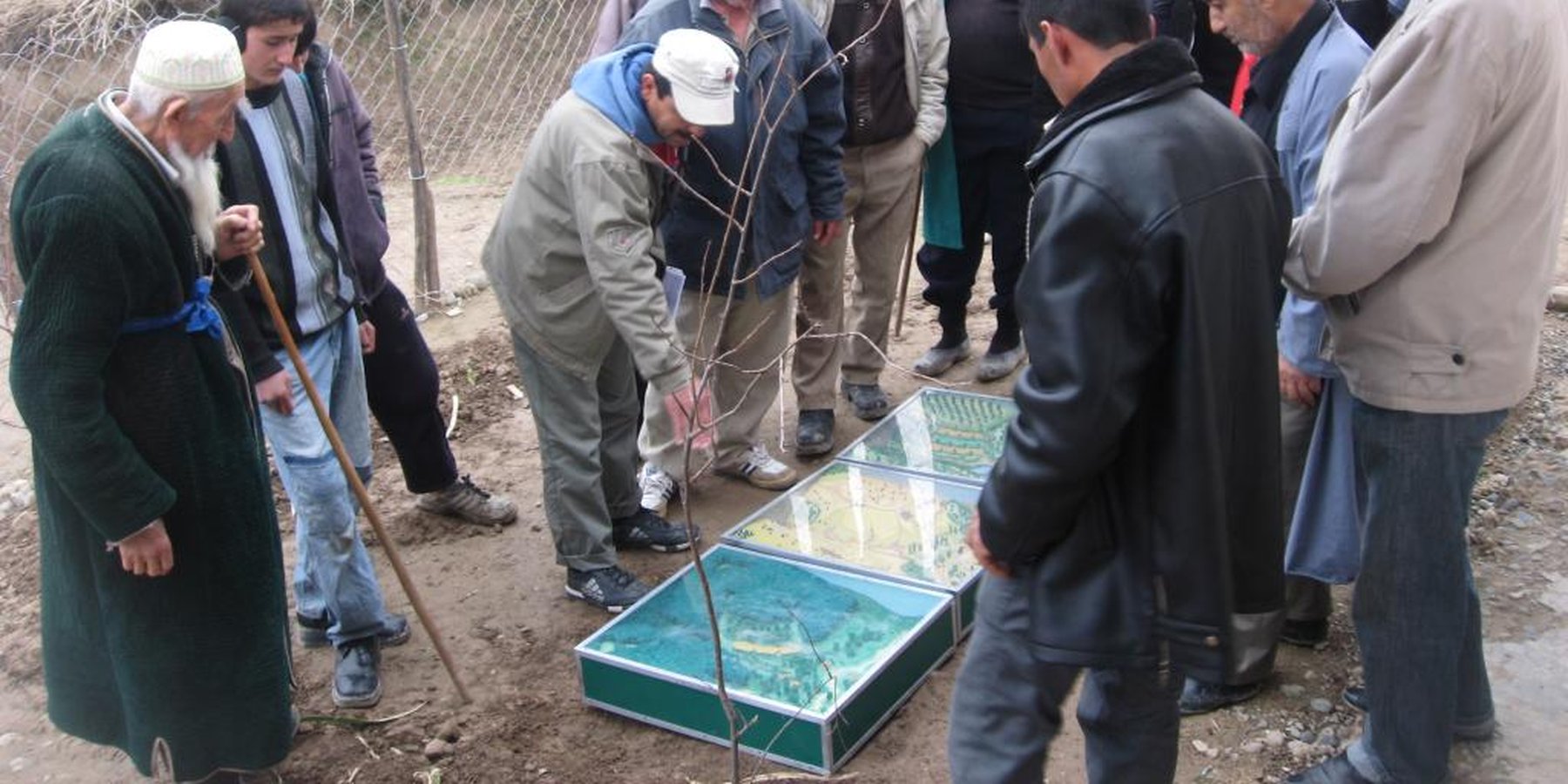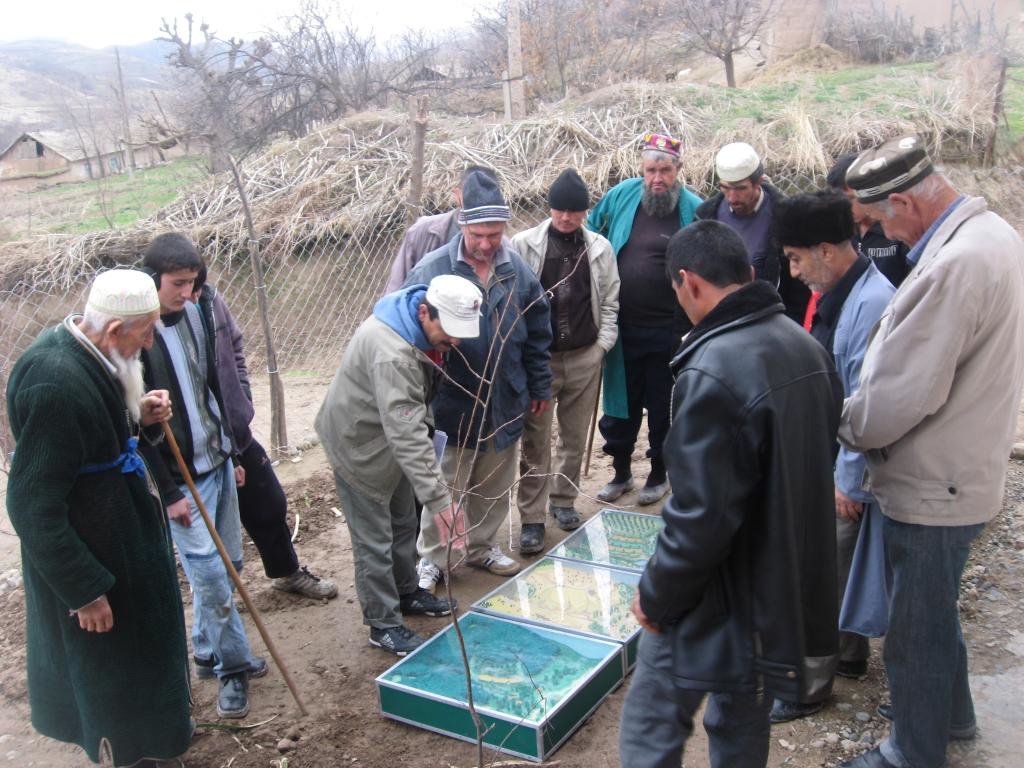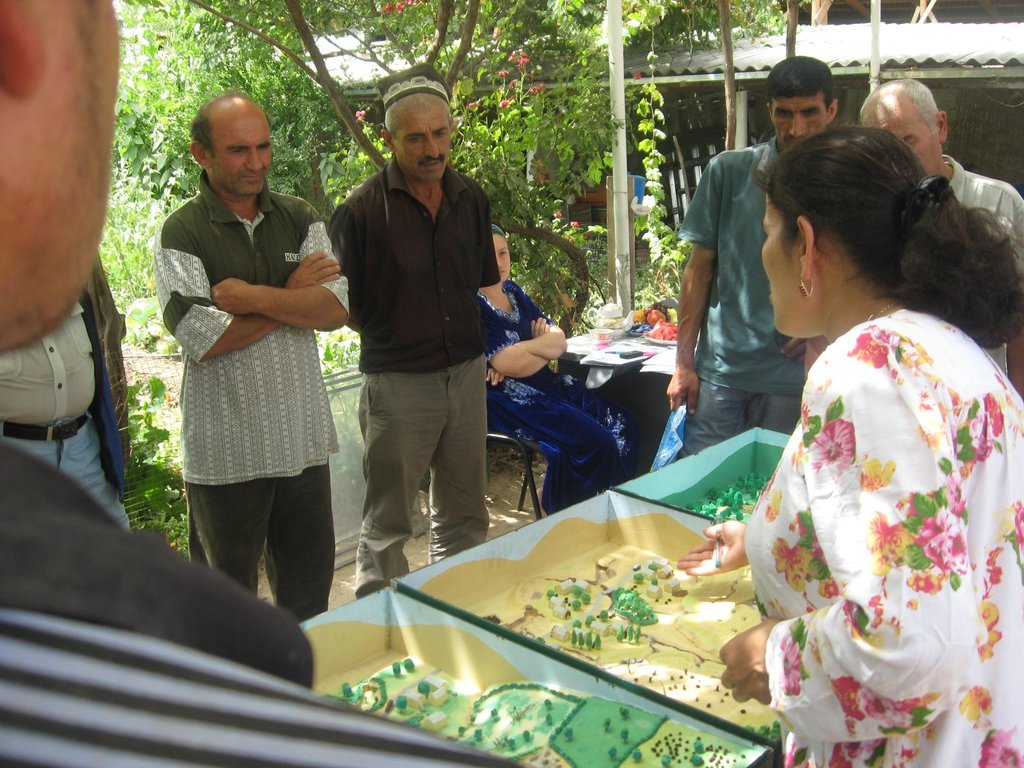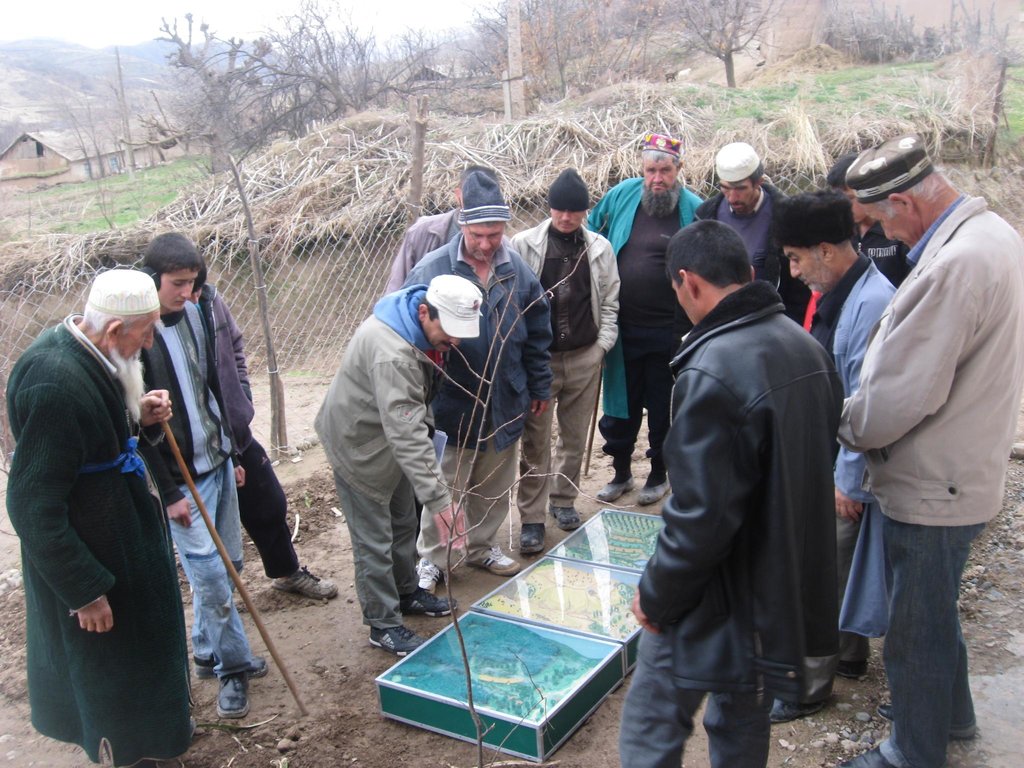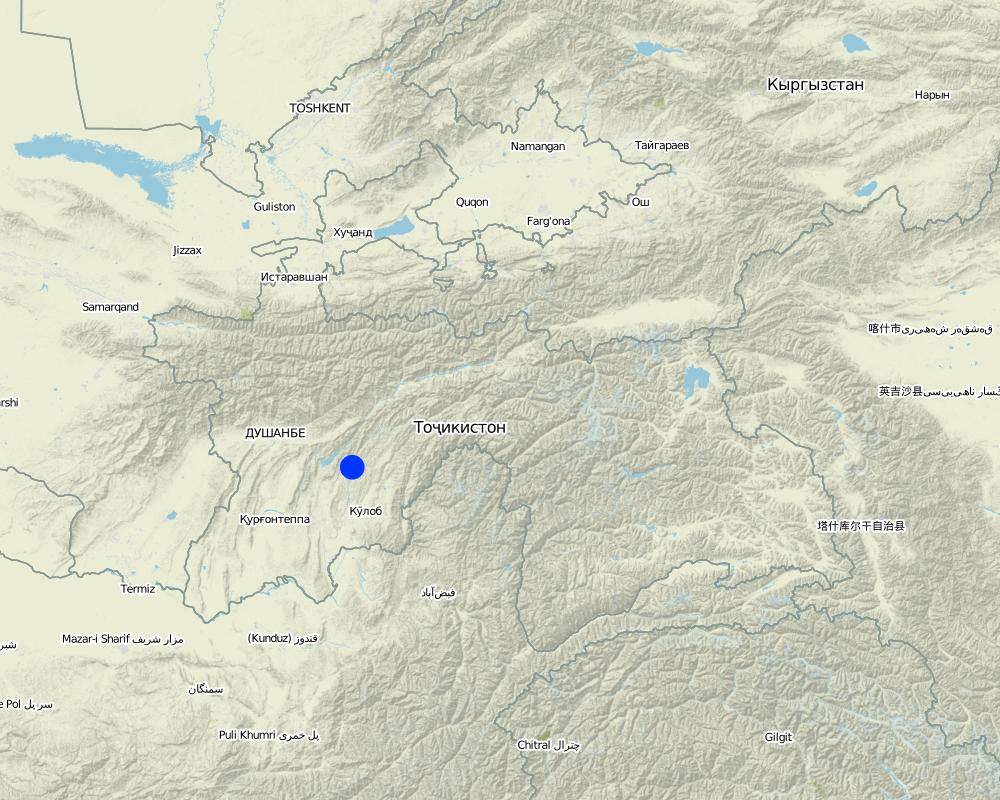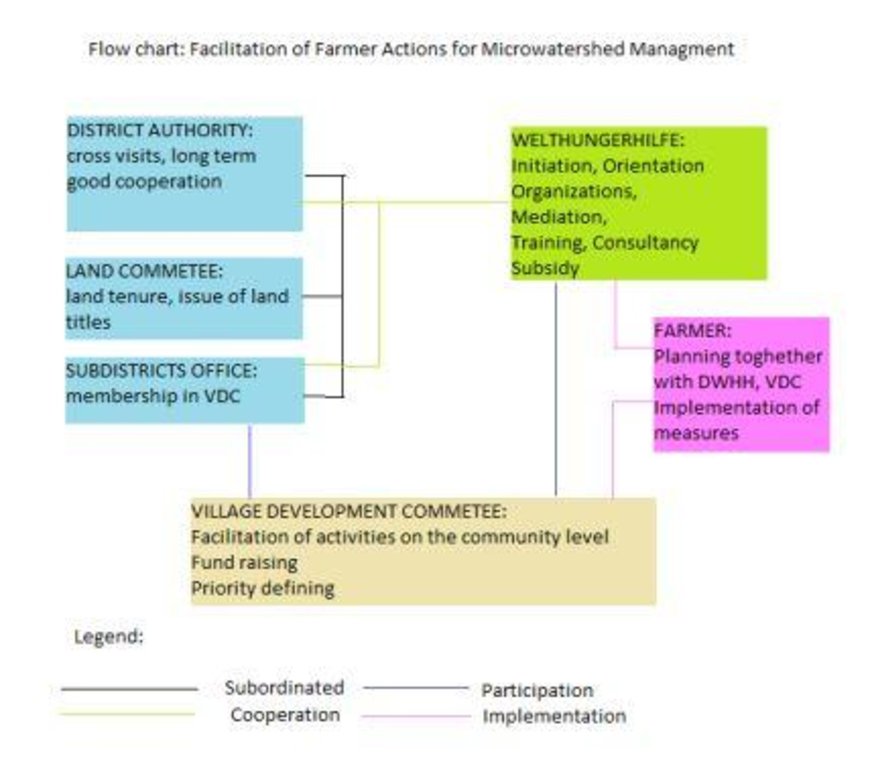Facilitation of micro-watershed management for farmers [طاجيكستان]
- تاريخ الإنشاء:
- تحديث:
- جامع المعلومات: Manuchehr Rakhmatdzhonov
- المحرر: –
- المراجعون: David Streiff, Alexandra Gavilano
Фасилитасияи амалиётхои дехкон барои идораи микрохавза
approaches_2443 - طاجيكستان
عرض الأقسام
توسيع الكل طي الكل1. معلومات عامة
1.2 تفاصيل الاتصال بالأشخاص الرئيسيين لمصدر المعلومات والمؤسسات المعنية بتقييم وتوثيق النهج
الشخص (الأشخاص) الرئيسي لمصدر المعلومات
متخصص في الإدارة المستدامة للأراضي:
متخصص في الإدارة المستدامة للأراضي:
متخصص في الإدارة المستدامة للأراضي:
متخصص في الإدارة المستدامة للأراضي:
Bronkal Daniel
daniel.bronkal@welthungerhilfe.de
ألمانيا
اسم المؤسسة (المؤسسات) التي سهلت توثيق/تقييم النهج (إذا كان ذلك على صلة)
Deutsche Welthungerhilfe (Welthungerhilfe) - طاجيكستان1.3 الشروط المتعلقة باستخدام البيانات الموثقة من خلال WOCAT
يوافق جامع المعلومات والشخص (لاشخاص) الرئيسي لمصدر المعلومات على الشروط المتعلقة باستخدام البيانات الموثقة من خلال WOCAT:
نعم
1.4 المراجع الخاصة باستبيان(استبيانات) تقنيات الإدارة المستدامة للأراضي
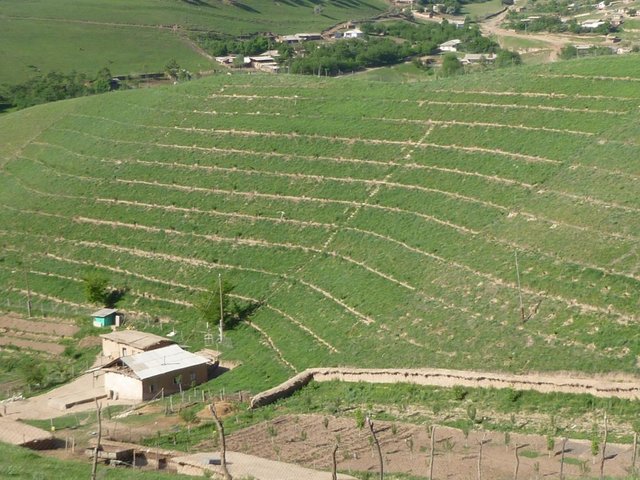
Gradual development of bench terraces from contour ditches [طاجيكستان]
Use of the SLM technology facilitates the development of bench terraces from contour channels by gradually removing soil material up the slope for an estimated 5 years until the terraces on the slope reach a desired width of 1.2 m.
- جامع المعلومات: Manuchehr Rakhmatdzhonov
2. وصف نهج الإدارة المستدامة للأراضي
2.1 وصف موجز للنهج
Relying on integrated watershed management principles, farmers were assisted by the project to implement soil and water conservation measures in a microwatershed.
2.2 وصف تفصيلي للنهج
وصف تفصيلي للنهج:
Aims / objectives: To strengthen the capacity of the community to plan and implement integrated natural resource management approaches, at micro watershed level in sustainable ways. These include; conserving soil by introducing actions to rehabilitate the eroded land, stop gully formation resulting from water run-off; enable water retention to secure soil moisture for a longer time period; mitigate effects of overstocking resulting in overgrazing; hoof erosion and soil compaction; reverse inappropriate agriculture practices towards more efficient and environmentally friendly management types; enable better employment and higher income generation to improve the livelihood standards and food security.
Methods: The project facilitated the following activities: Farmer participation, and using their initiative, community involvement in the planning, fundraising and implementation. Farmers increased their own contribution for material inputs, and a greater than 50% rate of adoption of the innovation was seen. The project also funded 'on the job' training, technical support, consultancy, and mediation of communication between parties.
Stages of implementation: 1. Awareness raising, 2. On the job training, 3. Watershed management activity planning, 4. Implementation, 5. Monitoring, 6. Evaluation, 7. Readjustment based on results, 8. Further replication in new area
Role of stakeholders: The DWHH Project had a leading role in initiation, orientation, awareness raising, mobilisation, training, consultancy, input provision and mediation of communication to land committee. Farmers have been actively participating, have provided labour input / financial contribution, provided indigenous knowledge and skills. Local authorities - providing land titles, participation in planning and decision making process Village Development Committee (VDC) - community mobilisation, information dissemination, input / finance documentation, fund raising.
Other important information: There are 5 households in the microwatershed. Almost 40 people live in all HH, all are Tajiks. Members of all households took part in discussion rounds and training. Non of HHs were strong enough to implement measures on own funds. One HH has rejected implementation of measures, due lack of capacity and lack of trust of the project's success. Women: farmers came to the discussions together with their wives, women took part in training, in implementing almost all of the adoption measures, and equally benefited from the project. However, they were not involved in decision making.
2.3 صور عن النهج
2.5 البلد/المنطقة/المواقع التي تم تطبيق النهج فيها
البلد:
طاجيكستان
المنطقة/الولاية/المحافظة:
Tajikistan, Khatlon
مزيد من التفاصيل حول الموقع:
Baljuvon / Khirob
Map
×2.6 تواريخ بدء وإنهاء تنفيذ النهج
أشر إلى سنة البدء:
2009
سنة الإنهاء (إذا لم يعد النهج مطبقًا):
2011
2.7 نوع النهج
- مبادرة محلية حديثة/مبتكرة
2.8 الغايات/الأهداف الرئيسية للنهج
The Approach focused mainly on SLM with other activities ( land use change, resource conservation, capacity building, focus on low cost local material, income generation, on the job training)
To assist farmers in the planning and implementation of activities for the conservation and improvement of the local land, to enable conditions for replication of the approach/technology, and to improve food production, and in the long run provide income generation.
The SLM Approach addressed the following problems: Lack of land tenure rights implementation. Nominal state farm reorganisation. Low agricultural production - lands depleted of nutrients, very low yields, no crop rotation, overgrazing. Soil degradation, progressing land mass transport, gully formation. Lack of technical knowledge and awareness of soil & water conservation measures. Lack of cash to invest in development of land - just limited capacity to invest but need external financial input. Conflict over land use - livestock owners are against land enclosures. Poverty - underlying cause of general lack of potential to invest in development.
2.9 الظروف التي تمكن أو تعيق تنفيذ التقنية/التقنيات المطبقة بموجب النهج
توفر/الوصول إلى الموارد والخدمات المالية
- معيق
Technology implementation has required a major investment for imported materials, like a metal net for fencing or fuel. Most farmers could not afford themselves to buy costly inputs. Moreover such inputs were rarely available on the local market.
Treatment through the SLM Approach: The INGO covered the costs of 50% of each action, here mainly higher price inputs were paid off. The low-cost approach fits the financial capacity of the target group.
الإطار المؤسساتي
- معيق
Capacities of communities and local authorities to jointly plan and implement SLM activities at micro-watershed level was weak.
Treatment through the SLM Approach: Knowledge improved on the complex interrelations in natural ecosystems (farmers and staff of local authorities). Project cooperation was not limited to those interested, there was inclusion of gov. structures (agriculture, land committee, ecology) committ
الإطار القانوني (حيازة الأراضي، وحقوق استخدام الأراضي والمياه)
- تمكين/تمكيني
The existing land ownership, land use rights / water rights moderately helped the approach implementation: On going legislative development in land tenure and farming provides good opportunities for implementation of the approach. But, ongoing nominal farm reorganisation and corruption at the local level, together with farmers reduced awareness of their land use rights requires more effort, time and funds in the application of SLM approaches. In this situation, DWHH has a good reputation in the district administration and with locals and so this helped overcome many barriers more easily.
- معيق
Implementing the land tenure law and the privatisation of state farms is still a difficult process with many inconsistencies for people claiming a land title in the area.
Treatment through the SLM Approach: There are a few instances where the project was able to support farmers in getting land-titles to degraded land plots which they then had to rehabilitate using SLM technologies.
المعرفة حول الإدارة المستدامة للأراضي، والوصول إلى الدعم الفني
- معيق
Treatment through the SLM Approach:
3. المشاركة وأدوار الأطراف المعنية
3.1 أصحاب المصلحة المعنيون بالنهج وأدوارهم
- مستخدمو الأراضي المحليون/المجتمعات المحلية
Village Development Committee, farmers
Men have played bigger role in the organisation of activities, in the implementation of more manual work, whereas, women took part in the lighter work and in routine maintenance.
Most of the participating households live below the poverty line.
Farmers joined under one microwatershed approach, male (wife assisted), middle age, Tajiks, rural middle class.
- متخصصون في الإدارة المستدامة للأراضي / مستشارون زراعيون
Project TAJ1068 staff, and an international consultant
- منظمة غير حكومية
Deutsche Welthungerhilfe
- الحكومة المحلية
Subdistrict, District Heads, Agriculture, Land committees, Forestry department
3.2 انخراط مستخدمي الأراضي المحليين/المجتمعات المحلية في المراحل المختلفة للنهج
| انخراط مستخدمي الأراضي المحليين/المجتمعات المحلية | حدد من شارك وصف الأنشطة | |
|---|---|---|
| المبادرة/التحفيز | تفاعلي | farmers meeting through VDC, orientation explaining goals, objectives, advertising in the local news paper, information boards in 6 watersheds |
| التخطيط | تفاعلي | on site planning with farmers |
| التنفيذ | تفاعلي | training on the job, material input and labour provision, cross visits |
| الرصد/التقييم | تفاعلي | data input, open to monitoring, communication on ongoing activities, collaboration while monitoring and evaluation |
| Research | تفاعلي | collaboration in the test for Acacia seed germination on the plot |
3.3 مخطط التدفق (إذا كان متاحًا)
الوصف:
Flow chart depicts the major actors involved during implementation of the approach. The relationship between stakeholders and primary functions is described as well.
المؤلف:
Manuchehr Rakhmatdzhonov (16, Firdavsi Street 734003, Dushanbe)
3.4 اتخاذ القرار بشأن اختيار تقنية/تقنيات الإدارة المستدامة للأراضي
حدد من الذي قرر اختيار التقنية/التقنيات التي سيتم تنفيذها:
- متخصصون في الإدارة المستدامة للأراضي بشكل أساسي، بعد التشاور مع مستخدمي الأراضي
اشرح:
Decisions on the method of implementing the SLM Technology were made by mainly by SLM specialists with consultation of land users. Focused on principles of farmer participation, self motivation and self help.
4. الدعم الفني وبناء القدرات وإدارة المعرفة
4.1 بناء القدرات/التدريب
هل تم تقديم التدريب لمستخدمي الأراضي / الأطراف المعنيين الآخرين؟:
نعم
حدد من تم تدريبه:
- مستخدمو الأراضي
- موظفون ميدانيون/ مستشارون
- local land and agriculture departments, village development committee
إذا كان ذلك على صلة، حدد الجنس والعمر والوضع والعرق وما إلى ذلك.
Land users: 5 men, 5 women, 30 to 50 years old, all Tajiks, all families.
شكل التدريب:
- في العمل
- مناطق العرض
- اجتماعات عامة
المواضيع المغطاة:
Use of the A-frame, watershed model, tree planting in contour ditches, intercropping
4.2 خدمة استشارية
هل يملك مستخدمو الأراضي وصولا إلى خدمة استشارية؟:
نعم
حدد ما إذا كانت الخدمة الاستشارية متوفرة:
- في حقول مستخدمي الأراضي
وصف/تعليقات:
A chain of meetings with international consultants from India and Nepal: Key elements: consultation on watershed concepts and watershed choice, capacity building in strategy design , draft development plan for watershed management
The consultants were : Yashvant Tkhakur, India; Jaganat Joschi, Nepal
Advisory service is inadequate to ensure the continuation of land conservation activities; the govenment branches need more development and organisation to become able to manage land conservation activities; an independent advisory service is not in place, the only potential still exists within the DWHH Project
4.3 تعزيز المؤسسات (التطوير التنظيمي)
هل تم إنشاء أو تعزيز مؤسسات من خلال هذا النهج؟:
- نعم، قليلا
حدد المستوى (المستويات) التي تم فيها تعزيز أو إنشاء المؤسسات:
- محلي
حدد نوع الدعم:
- بناء القدرات/التدريب
اعط مزيدا من التفاصيل:
Village development committee (VDC), use of locally available resources, focus on low cost
4.4 الرصد والتقييم
هل يشكل الرصد والتقييم جزءا من النهج؟:
نعم
التعليقات:
area treated aspects were ad hoc monitored by land users through observations; indicators: space used for technology
economic / production aspects were regular monitored by project staff through measurements; indicators: fodder produced cent/ha, vegetables
socio-cultural aspects were ad hoc monitored by project staff through observations; indicators: labour availability, health status
technical aspects were ad hoc monitored by project staff through observations; indicators: tree planting
bio-physical aspects were ad hoc monitored by project staff through observations; indicators: soil degradation, gully formation
no. of land users involved aspects were ad hoc monitored by project staff through observations; indicators: monthly trends, how hardworking they were, gender
management of Approach aspects were ad hoc monitored by land users through observations; indicators: technology adaptation based on own experience
There were no changes in the Approach as a result of monitoring and evaluation: None
There were few changes in the Technology as a result of monitoring and evaluation: Change of the design - adjustment of the contour boundary based on experience on the plot; Adjusting of tree planting in contour ditches according to the topography
4.5 البحوث
هل كانت البحوث جزءًا من النهج؟:
نعم
حدد المواضيع:
- تكنولوجيا
أعط تفاصيل إضافية وأشر إلى من قام بالبحوث:
Tests were completed on the germination of Acacia seeds in two different setups: on the demo plot of the project and on the farmers plot.
Research was carried out both on station and on-farm
5. التمويل والدعم المادي الخارجي
5.1 الميزانية السنوية لمكون الإدارة المستدامة للأراضي في النهج المذكور
إذا لم تكن الميزانية السنوية الدقيقة معروفة، قم بالإشارة إلى نطاقها:
- 10,0000-2,000
التعليقات (على سبيل المثال المصادر الرئيسية للتمويل/الجهات المانحة الرئيسية):
Approach costs were met by the following donors: international non-government (material input: tools, fencing, planting material, diesel. etc.): 50.0%; local community / land user(s) (the rest of material input, labour, time (mainly low cost inputs)): 50.0%; other
5.2 الدعم المالي/المادي المقدم لمستخدمي الأراضي
هل حصل مستخدمو الأراضي على دعم مالي/ مادي لتنفيذ التقنية/ التقنيات؟:
نعم
إذا كانت الإجابة بنعم، حدد نوع (أنواع) الدعم والشروط والمزودين:
50% of activities were subsidised by the DWHH Project TAJ1068
5.3 إعانات لمدخلات محددة (بما في ذلك العمالة)
- معدات
| حدد المدخلات التي تم دعمها | إلى أي مدى | حدد الإعانات |
|---|---|---|
| أدوات | ممول جزئيا | hand tools |
- زراعة
| حدد المدخلات التي تم دعمها | إلى أي مدى | حدد الإعانات |
|---|---|---|
| بذور | ممول جزئيا | |
| manure | ممول جزئيا | |
- بناء
| حدد المدخلات التي تم دعمها | إلى أي مدى | حدد الإعانات |
|---|---|---|
| metal net | ممول بالكامل | |
- بنى تحتية
| حدد المدخلات التي تم دعمها | إلى أي مدى | حدد الإعانات |
|---|---|---|
| مدارس | ممول جزئيا | school, 2 rooms thermo insulated |
- غير ذلك
| غير ذلك(حدد) | إلى أي مدى | حدد الإعانات |
|---|---|---|
| Fuel, diesel, oil | ممول جزئيا | 1/4 of the need |
إذا كان العمل من قبل مستخدمي الأراضي مدخلاً جوهريًا، فهل كان:
- تطوعي
التعليقات:
Rennovation of the chool for the children was a strong and vital argument demanding considerable investment. This was competed with the implementation of the SLM technology, where farmers had to make a choice; either spend the available funds for the school or continue with the SLM. The project has provided partial financial and technology support to farmers which made it easy to overcome the school situation and concentrate again on SLM activities.
5.4 الائتمان
هل تم توفير ائتمان في إطار نهج أنشطة الإدارة المستدامة للأراضي؟:
كلا
5.5 حوافز أو وسائل أخرى
هل تم استخدام حوافز أو أدوات أخرى لتشجيع تنفيذ تقنيات الإدارة المستدامة للأراضي؟:
نعم
إذا كانت الإجابة بنعم، حدد:
Village development committee (VDC), use of locally available resources, focus on low cost
6. تحليل الأثر والتصريحات الختامية
6.1 آثار النهج
هل ساعد النهج مستخدمي الأراضي على تنفيذ وصيانة تقنيات الإدارة المستدامة للأراضي؟:
- لا
- نعم، قليلا
- نعم، باعتدال
- نعم، إلى حد كبير
Most of the previous types of damage caused by water runoff were prevented. Trees grew in a landscape where they didn't before, due to long dry periods and high livestock pressure from grazing. There was a change in the farmer's attitudes, who prior to witnessing the technology were highly sceptical
هل ساهم النهج في تمكين الفئات المحرومة اجتماعيا واقتصاديا؟:
- لا
- نعم، قليلا
- نعم، باعتدال
- نعم، إلى حد كبير
Only four families out of five in the microwatershed were able to receive the opportunity to improve their socio-economic status in the long term as a result of the project.
هل أدى النهج إلى تحسن في مسائل حيازة الأراضي / حقوق المستخدمين التي أعاقت تنفيذ تقنيات الإدارة المستدامة للأراضي؟:
- لا
- نعم، قليلا
- نعم، باعتدال
- نعم، إلى حد كبير
The approach has added to the farmers self belief, ensured that they will effectively use existing land resources, and following the sustainable improvement of soil conditions, should add good potential for their own economic growth.
Did other land users / projects adopt the Approach?
- لا
- نعم، قليلا
- نعم، باعتدال
- نعم، إلى حد كبير
Farmers from the neighbouring watershed, came repeatedly to observe the plot. Three of these farmers adopted the technology themselves in the following year.
Did the Approach lead to improved livelihoods / human well-being?
- لا
- نعم، قليلا
- نعم، باعتدال
- نعم، إلى حد كبير
Vegetables could be grown to supply more food to the family, a good amount of hay could be prepared for winter time, more benefits could be seen in the long run with extra fruits and fire wood
Did the Approach help to alleviate poverty?
- لا
- نعم، قليلا
- نعم، باعتدال
- نعم، إلى حد كبير
This was a pilot project, and only looked at poverty alleviation on a small scale. This technology has the potential to reduce poverty in the long term on a bigger scale.
6.2 المحفز الرئيسي لقيام مستخدمي الأراضي بتنفيذ الإدارة المستدامة للأراضي
- زيادة الإنتاج
- زيادة الربح (القدرة)، وتحسين نسبة التكلفة إلى العائد
- انخفاض عبء العمل
- المدفوعات/ الإعانات
- الوعي البيئي
- well-being and livelihoods improvement
6.3 استدامة أنشطة النهج
هل يمكن لمستخدمي الأراضي المحافظة على استدامة ما تم تنفيذه من خلال النهج (بدون دعم خارجي)؟:
- نعم
إذا كانت الإجابة بنعم، صف كيف:
Yes, but only those who would have enough funds to implement costliest part of technology: the perimeter fencing (metal net). Overall, most farmers will happily continue with the implementation of the technology, if the initial costs are subsidised. There are also a few new farmers who were able to replicate the technology completely by themselves.
6.4 نقاط قوة/مزايا النهج
| نقاط القوة/ المزايا/ الفرص من وجهة نظر مستخدمي الأراضي |
|---|
| The approach to share the implementation costs, consideration of general social needs, good project communication. (How to sustain/ enhance this strength: More donor funding would be required to support more local farmers in the future. ) |
| The approach has enabled a range of innovations that were never used before: contour lines, mulching etc. |
| The approach has helped to reveal the local problems related to technology implementation. It has helped participants to learn about the strength and potential of local land users in the implementation of the SLM approach and technology. (How to sustain/ enhance this strength: Lessons learned must be applied in the future implementation of SLM actions and replication. ) |
| نقاط القوة/ المزايا/ الفرص من وجهة نظر جامع المعلومات أو غيره من الاشخاص الرئيسيين لمصدر المعلومات |
|---|
| The approach enabled the use of both international and local knowledge. Attention was given to capacity building and sustaining the organisation, as well as the mobilisation structure (VDC) at the grass roots level. (How to sustain/ enhance this strength: All the knowledge experience gained from the project has to be documented and disseminated for replication.) |
| The reputation of DWHH, and long term collaboration with the Baljuvon district administration played a very positive role in the successful implementation of the conservation approach. (How to sustain/ enhance this strength: Members of the local authority should be continuously involved in training, capacity building and planning measures. ) |
6.5 نقاط الضعف/ العيوب في المنهج وطرق التغلب عليها
| نقاط الضعف/ المساوىء/ المخاطر من وجهة نظر مستخدم الأراضي | كيف يمكن التغلب عليها؟ |
|---|---|
| Sometimes the approach enabled unproductive discussions during the planning and designing phases. | Project ambitions and objectives have to be adjusted to the local situation and farmer capacity and needs. |
| Farmers were facing situations where their other social and economic needs were strongly competing with the objectives of the project. | Some additional funds, may need to be provided and more awareness of the farmer's situations need to be taken into account. |
| نقاط الضعف/ المساوىء/ المخاطر من وجهة نظر جامع المعلومات أو غيره من الاشخاص الرئيسيين لمصدر المعلومات | كيف يمكن التغلب عليها؟ |
|---|---|
| The approach required a lot of funding until the majors actors were trained and had the capacity to implement the conservation measures. |
7. المراجع والروابط
7.1 طرق جمع/مصادر المعلومات
- زيارات ميدانية، مسوحات ميدانية
- مقابلات مع مستخدمي الأراضي
7.2 المراجع للمنشورات المتاحة
العنوان، المؤلف، السنة، النظام القياسي الدولي لترقيم الكتب ISBN:
Grant Application Form to EU Commission: 'Individual incomes & Improving Living Standarts in Khatlon and Sughd Regions', TajikistanSketch map of Khirob MicrowatershedInterim Narrative Report 01.05.2009-30.04.2010 Project TAJ 1068
متاح من أين؟كم التكلفة؟:
DWHH Regional Office, Dushanbe
العنوان، المؤلف، السنة، النظام القياسي الدولي لترقيم الكتب ISBN:
Sketch map of Khirob Microwatershed
متاح من أين؟كم التكلفة؟:
DWHH, Baljuvon
العنوان، المؤلف، السنة، النظام القياسي الدولي لترقيم الكتب ISBN:
Interim Narrative Report 01.05.2009-30.04.2010 Project TAJ 1068
متاح من أين؟كم التكلفة؟:
DWHH, Baljuvon
الروابط والوحدات المواضيعية
توسيع الكل طي الكلالروابط

Gradual development of bench terraces from contour ditches [طاجيكستان]
Use of the SLM technology facilitates the development of bench terraces from contour channels by gradually removing soil material up the slope for an estimated 5 years until the terraces on the slope reach a desired width of 1.2 m.
- جامع المعلومات: Manuchehr Rakhmatdzhonov
الوحدات المواضيعية
لا يوجد وحدات مواضيعية


